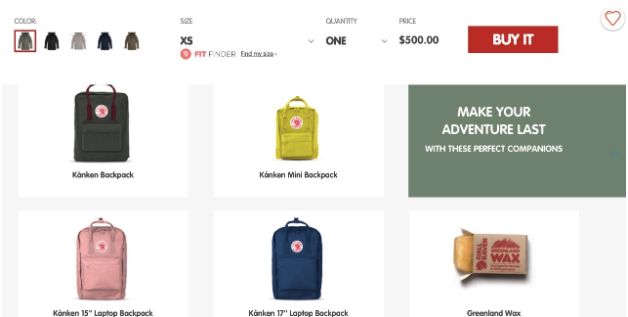Full-scale personalization: A Fjällräven case study
How Fjallraven, the legendary Swedish outdoor gear company, increases conversions and CTR through recommendations and personalized messaging.
Summarize this articleHere’s what you need to know:
- Fjällräven increased conversions and CTR through personalization, catering to diverse audiences with product recommendations, messaging, and dynamic content.
- Time-based overlays for holiday shipping options and weather-based product targeting further enhanced the shopping experience.
- Specific examples include a 30% revenue boost from overnight shipping overlays, 38% higher conversions from low-stock messaging, and increased average order value from product recommendations.
- Personalization empowers retailers to tailor experiences, driving sales and improving customer satisfaction.
Founded in 1960 in Sweden, Fjällräven is a leading brand in outdoor gear and equipment, known for its commitment to quality and sustainability. To encourage purchase completion and help users discover new products, Fjällräven used personalization to optimize product recommendations and serve tailored messaging. We sat down with Sam Minassian, the ex-Director of Ecommerce & Digital Marketing at Fjällräven North America, to learn about the challenges and rewards of personalization.
From backpacks to parkas, Fjällräven has a diverse set of men’s and women’s clothing and outdoor gear to satisfy both the hardcore outdoorsmen and the urban chic. Creating online shopping experiences that encourage users to discover products they didn’t yet know they needed or wanted was the challenge that Fjällräven faced.
Though the Swedish outdoors clothing and gear company was built on the back of a very durable, comfortable-to-wear backpack for the hiking type, the brand had also become popular with the metropolitan, fashionable set. Fjällräven had users coming to the site with different purposes and had to figure out how to, in essence, serve two masters at the same time.
For Fjallraven, the answer was personalization. To craft onsite experiences that encouraged these diverse audiences to buy, Fjällräven required a personalization engine that could:
- Create experiences that made it easy for visitors to discover new items.
- Serve personalized messaging that enticed visitors to complete purchases.
As Sam Minassian explains: “Our brand is pretty unique and we are well known for our bags. We have some really popular bags. But our bag consumer is very different from our hiking/trekking/backpacking customer. One is a fashion consumer; one is an outdoor consumer. The fashion consumer is usually female between the ages of 18-35 and our outdoors consumer is typically male.“
“So we have different customer segments. When they come to our site, we want to offer the appropriate products and deals to the relevant customer segment. If we wanted to reduce the number of clicks that it takes each customer to get to relevant products, we had to personalize.“
“But we also want to get the backpack customer to consider our outdoor products. So how do we get a 22 year customer who wants to a backpack to look at a down jacket? We are doing gender-specific experiences based on past on website behavior. We can really pinpoint customers much more easily.“
Helping users discover (and buy) new products
Fjällräven essentially wanted to take this strategy further and adjust it to seasonality. This would allow them to maximize conversions during the busy holiday shopping season and beyond. To achieve this, Fjällräven deployed value- and time-based shipping overlays during Christmas time.
Before the start of the Christmas shopping season, the company offered its users five different types of free shipping options via overlay messaging. They were: overnight, ground shipping, express saver, two-day, and smart post.
The message deployed depended on the value of the items that were being placed into a shopper’s cart and timing. The closer it got to the holiday, the fewer options customers were presented with – the ones that wouldn’t get guarantee a Christmas arrival were removed — and more traffic was allocated to the best performing variation.
The overnight shipping option was the most effective variation, leading to a staggering 30% in uplift revenue per user through all of the message variants showed uplift when compared to the control.

As Sam Minassian further explains: “We had a program for the holidays where we had different free shipping thresholds. In a short amount of time, we were able to implement them and test them.“
“To encourage customers to reach the “free shipping” threshold, we sent in-cart notifications such as, “Add another $50 to get free overnight shipping.” We were unable to do this before we started using Dynamic Yield.“
Deploying social proof and low-in-stock messaging to drive urgency
To heighten demand, Fjällräven prominently displayed “low in stock” message overlay for popular items, which alerted consumers that the items they were browsing were soon to be sold out. As Sam states: “We also played around with low inventory messaging to create urgency and exit intent messaging to keep people from leaving the page before making a purchase.“
Think about it- if you find a perfect jacket and are served a message saying that it might not be there tomorrow, there’s an extra incentive to complete your purchase right away before your friend texts you to spend that money on tickets to Cabo.
The low in stock messaging successfully stimulated this urgency, leading to 38% uplift in conversions among the group that received the overlay. “If you found a perfect jacket and then you receive a message says that you shouldn’t wait another day because it’s about to sell out, the consumer has an incentive to buy.” Says Sam. “The customer is thinking, ‘If I don’t buy it now, I have to wait until next winter to get it.'”

Experimenting with advanced segmentation and targeting
Fjällräven are constantly trying to improve their audience segmentation practices. They want to dial in even more to the kind of person who comes to the site. They want to get more granular with the male/female audiences and better understand what products they are looking at. As Sam explains: “We want to know how to make our website experience faster and more convenient for them [the consumers]. All of that stems from Dynamic Yield’s audience segmentation engine.”
As a company that specializes in outdoor gear, weather-based targeting is another effective way of creating hyper-relevant experiences. As mentioned by Sam: “We also wanted to segment based on other factors. If they’re coming from snowy locations, we want to offer them different stuff than if they’re coming from a rainy location. With personalization, we can mirror what’s happening right outside their window. It has done amazing things for us in getting the right products in front of the right people.“
Adding personalized PDP recommendations to maximize product discoverability
To improve product discovery and increase time on site and pages viewed, Fjallraven wanted to display similar items on product pages targeted to a user’s preferences. When Fjallraven deployed this tactic, the company was looking to increase unit CTR so that users would view more products and become better acquainted with offerings that might be of interest to them. Specifically, the company wanted to entice users who came to Fjallraven for one specific product (such as the iconic Kanken backpack) to discover the brand’s other product lines.

Product page recommendations with similar items led to amazing results. In addition, successful product page recommendations also boosted the quantity of products in each order and average order value.
Sam Minassian: “PDP product recommendations have been huge. With personalization, we went from something that was completely ineffective to something that was crucial in our product pages and our cart pages. We are now able to take a customer based on what they are shopping for — and show other products, in the correct size, that might go with their jacket. We have seen big increases in Average Order Value.”
Omnichannel retailing at scale is increasingly being recognized as marketing’s holy grail. Customers expect personalized experiences across touchpoints and eCommerce leaders have cited personalization as their top priority and investment area. Outdoor gear and equipment retailer Fjällräven was able to increase revenue and sales by deploying personalization, product recommendations, personalized messaging, and social proof.
Discover over a hundred real website personalization examples from around the world to kickstart ideation
